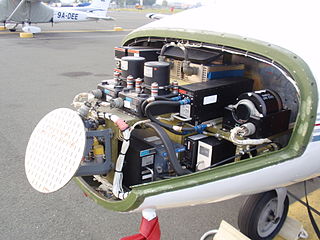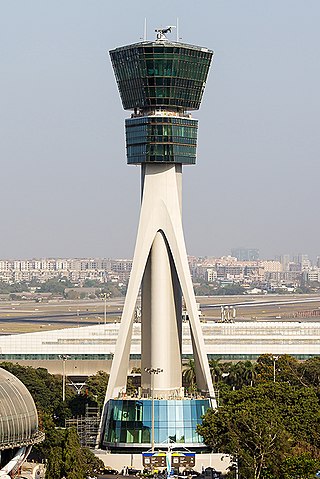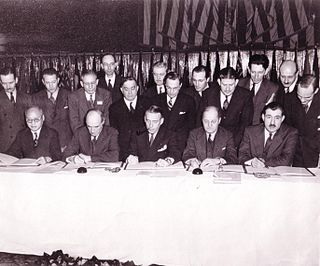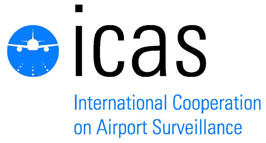
Avionics are the electronic systems used on aircraft. Avionic systems include communications, navigation, the display and management of multiple systems, and the hundreds of systems that are fitted to aircraft to perform individual functions. These can be as simple as a searchlight for a police helicopter or as complicated as the tactical system for an airborne early warning platform.

Air traffic control (ATC) is a service provided by ground-based air traffic controllers who direct aircraft on the ground and through a given section of controlled airspace, and can provide advisory services to aircraft in non-controlled airspace. The primary purpose of ATC is to prevent collisions, organise and expedite the flow of traffic in the air, and provide information and other support for pilots.
Mechatronics engineering, also called mechatronics, is an interdisciplinary branch of engineering that focuses on the integration of mechanical engineering, electrical engineering, electronic engineering and software engineering, and also includes a combination of robotics, computer science, telecommunications, systems, control, automation and product engineering.

Aircrew, also called flight crew, are personnel who operate an aircraft while in flight. The composition of a flight's crew depends on the type of aircraft, plus the flight's duration and purpose.

The Convention on International Civil Aviation, also known as the Chicago Convention, established the International Civil Aviation Organization (ICAO), a specialized agency of the United Nations charged with coordinating international air travel. The Convention establishes rules of airspace, aircraft registration and safety, security, and sustainability, and details the rights of the signatories in relation to air travel. The convention also contains provisions pertaining to taxation.

The Airports Authority of India (AAI) is a statutory body under the ownership of the Ministry of Civil Aviation, Government of India. It is responsible for creating, upgrading, maintaining, and managing civil aviation infrastructure in India. It provides Communication Navigation Surveillance/Air Traffic Management (CNS/ATM) services over the Indian airspace and adjoining oceanic areas. AAI currently manages a total of 137 airports, including 34 international airports, 10 Customs Airports, 81 domestic airports, and 23 Civil enclaves at Defense airfields. AAI also has ground installations at all airports and 25 other locations to ensure the safety of aircraft operations. AAI covers all major air routes over the Indian landmass via 29 Radar installations at 11 locations along with 700 VOR/DVOR installations co-located with Distance Measuring Equipment (DME). 52 runways are provided with Instrument landing system (ILS) installations with Night Landing Facilities at most of these airports and an Automatic Message Switching System at 15 Airports.

An electronic flight bag (EFB) is an electronic information management device that helps flight crews perform flight management tasks more easily and efficiently with less paper providing the reference material often found in the pilot's carry-on flight bag, including the flight-crew operating manual, navigational charts, etc. In addition, the EFB can host purpose-built software applications to automate other functions normally conducted by hand, such as take-off performance calculations. The EFB gets its name from the traditional pilot's flight bag, which is typically a heavy documents bag that pilots carry to the cockpit.
The Future Air Navigation System (FANS) is an avionics system which provides direct data link communication between the pilot and the air traffic controller. The communications include air traffic control clearances, pilot requests and position reporting. In the FANS-B equipped Airbus A320 family aircraft, an Air Traffic Services Unit (ATSU) and a VHF Data Link radio (VDR3) in the avionics rack and two data link control and display units (DCDUs) in the cockpit enable the flight crew to read and answer the controller–pilot data link communications (CPDLC) messages received from the ground.

Operations Specialist is a United States Navy and United States Coast Guard occupational rating. It is a sea duty-intensive rating in the Navy while most of Coast Guard OS's are at ashore Command Centers.

Gillham code is a zero-padded 12-bit binary code using a parallel nine- to eleven-wire interface, the Gillham interface, that is used to transmit uncorrected barometric altitude between an encoding altimeter or analog air data computer and a digital transponder. It is a modified form of a Gray code and is sometimes referred to simply as a "Gray code" in avionics literature.

State University "Kyiv Aviation Institute" is a public aviation university in Kyiv, Ukraine.

The International Cooperation on Airport ATM Systems (ICAS) is a group of Airports, Air Navigation Service Providers (ANSPs) and EUROCONTROL.
International Federation of Air Traffic Safety Electronics Associations (IFATSEA) unites the professional associations of air traffic safety electronics personnel (ATSEPs) from around the world.
The Directorate General of Civil Aviation (DGCA) is a statutory body of the Government of India to regulate civil aviation in India. It became a statutory body under the Aircraft (Amendment) Act, 2020. The DGCA investigates aviation accidents and incidents, maintains all regulations related to aviation and is responsible for issuance of licenses pertaining to aviation like PPL's, SPL's and CPL's in India. It is headquartered along Sri Aurobindo Marg, opposite Safdarjung Airport, in New Delhi. The Government of India is planning to replace the organisation with a Civil Aviation Authority (CAA), modelled on the lines of the American Federal Aviation Administration (FAA).

CIMACT is EUROCONTROL's Civil-Military Air Traffic Management Co-ordination Tool.
CS Group, initially known as Communication & Systèmes (CS), is a French information-technology service company listed on the Paris Bourse as a member of the CAC Small index. The company designs information systems, develops and integrates software, manages projects and deploys industrial applications. Apart from that, it provides science, technology, and consulting services. CS Group is the French leader in air traffic control, the third-biggest supplier of traffic-management systems in the world and provides information technology consulting services.
The Academy of Technical Training is a privately owned institution which provides training programs in aviation security and safety, air traffic control, and management of aircraft accidents. The curriculum and courses are accredited and certified by the General Civil Aviation Authority.

In aviation, the SHELL model is a conceptual model of human factors that helps to clarify the location and cause of human error within an aviation environment.

Airway Transportation Systems Specialists', also known as (ATSSs; FV-2101) are Systems Electronics Technicians assigned to the Technical Operations (TechOps) section of the Federal Aviation Administration's Air Traffic Organization (ATO). Airway Transportation Systems Specialists possess theoretical and practical knowledge in electronic theory and characteristics, functions, operations, and capabilities of a variety of National Airspace System (NAS) systems. Airway Transportation Systems Specialists ensure the safety and efficiency of the NAS by performing preventive maintenance, corrective maintenance, and system modifications of air traffic control systems at ATCTs, TRACONs, and ARTCCs throughout the United States of America and its territories. ATSS generally possesses years of experience in a variety of U.S. National Airspace System (NAS) systems. Airway Transportation Systems Specialists are responsible for the maintenance, operation, fabrication, installation, and management of the technical infrastructure of the National Airspace System. Airway Transportation Systems Specialists work at different Systems Support Centers (SSCs) in the United States. Airway Transportation Systems Specialists install, maintain, repair, operate, and monitor hardware and software to ensure they work as designed. ATSS certifies equipment and services to ensure safe and efficient flight operations throughout NAS. The FAA workforce currently includes 5,200 ATSS nationwide.












